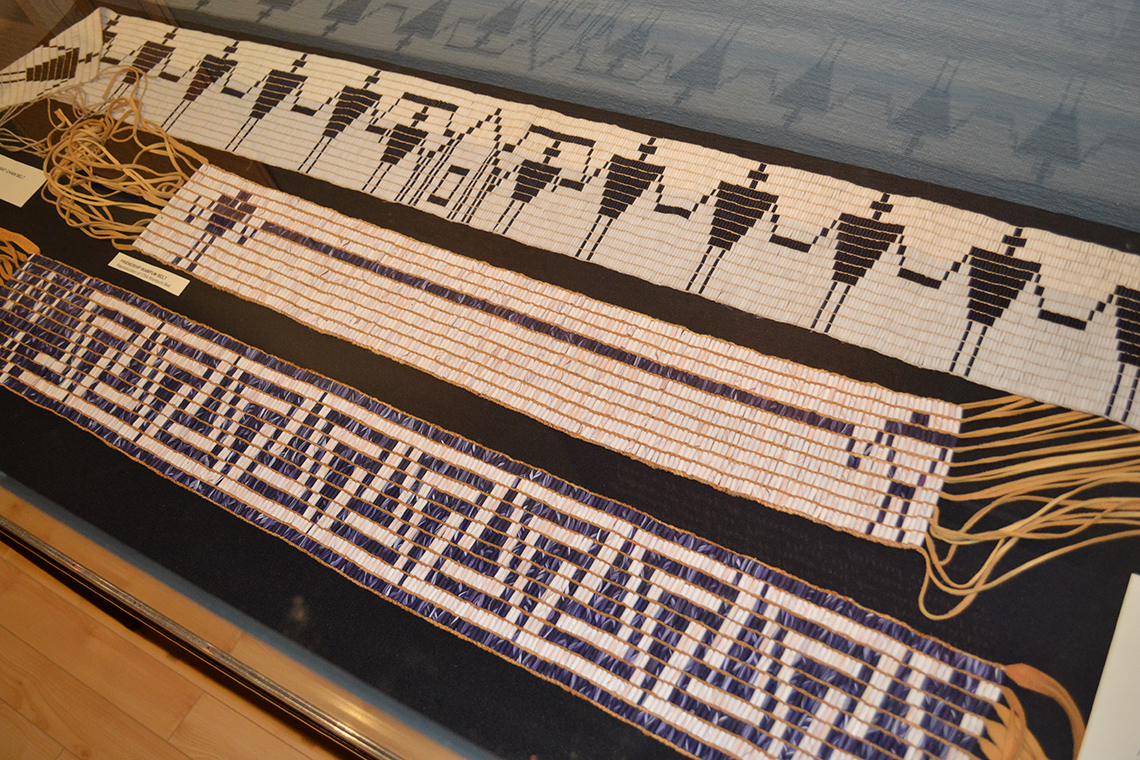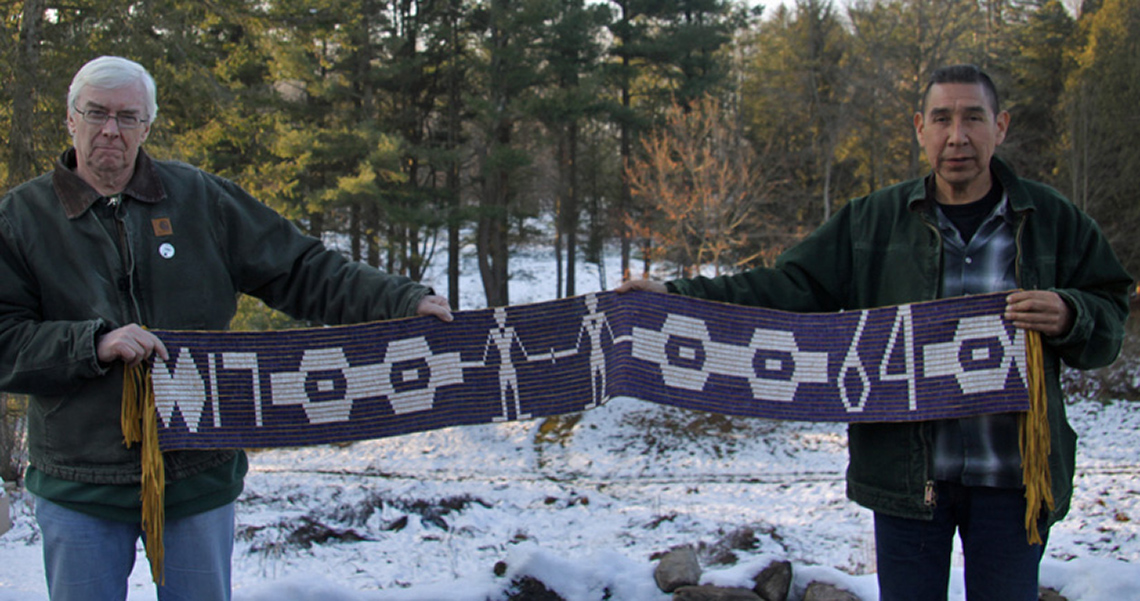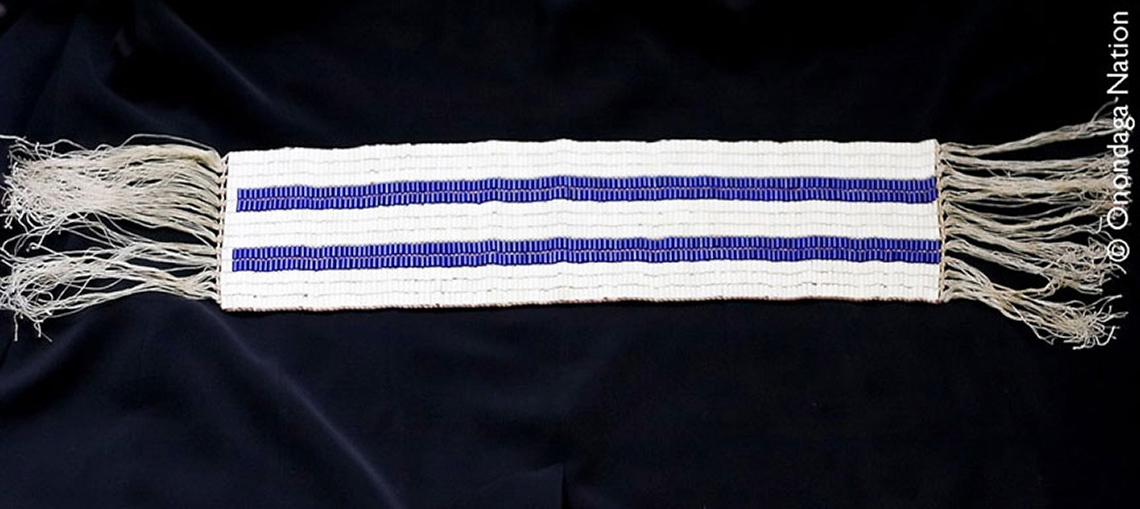Minds On
How is the past remembered?
Explore the details of the first wampum belt in the following image.

Wampum belt questions
Answer the following questions about the wampum belt you examined.
- How do you think this belt was made?
- What do you think the design on the wampum belt may mean?
- What can the wampum belt tell us about the relationship between people?
Throughout this learning activity, you can record your answers on the computer, orally, or on paper.
Action
Wampum belts

When we study the past, we sometimes use primary sources to understand what happened. One of the most valuable sources for understanding the past on Turtle Island are wampum belts.
Press Sources to access an explanation of the different types of sources of historical information.
Primary source: documents, images, or objects that provide information or narrative from people who experienced an event as it was happening. Primary sources are ususally made at the time of the event or shortly after.
Secondary source: documents, images, or objects that were created by someone who did not directly experience an event. Secondary sources are often books or articles by experts on certain events. Secondary sources often refer to primary sources to support their analysis.
A wampum belt provides a way of understanding past events and gives us an opportunity to read history. The patterns provide a timeline and describe events and agreements or treaties between various Indigenous nations. The words of the agreement are woven into the belts and the speaker uses the wampum to remember the agreement. Certain representatives, called knowledge keepers (or wampum keepers), ensure the safety of the belts and retain the histories embedded in the belts. Some of these stories can take days to tell; each bead and the symbols that are woven into the belt hold great value to Indigenous record keeping. Wampum belts represent the living history for different nations including Haudenosaunee, the Mi’kmaq, and the Anishinaabe.
Wampum belts are made from whelk (sea snail) and quahog (clam) shells. The purple and white parts of the shell are sanded and rounded to make the beads. To create these beads requires a very specialized skillset and is labour-intensive; this is one of the many reasons why wampum is so highly valued and respected as an art form.

Image of Rich Hamell and Paul Winnie of the Wampum Bear organization are holding the Ft. Niagara Wampum Belt. The wampum belt has a series of images created with beads made from quahog or whelk shells. Both shells produce white beads, but only parts of the quahog produce purple beads. The images on the wampum have a series of two identical shapes connected beside another set of identical shapes connected. There is a date on the belt that says 1764 and in the middle of the belt is an image of two identical people holding hands with their second hand holding one of the identical shape pairs.
Wampum belts were not only used to show relations between First Nations communities but also between First Nations and European settlers. Treaties are agreements that are made between two nations and are legally binding. There is a long history of treaty-making on Turtle Island, or the lands that are now referred to as Canada. First Nations communities created their own treaties between nations that outlined each nation’s roles and responsibilities. These treaties were recorded orally, through storytelling, and also visually, through objects like wampum belts.
Wampum belts of the Haudenosaunee
Wampum belts are an important part of Haudenosaunee culture. The Haudenosaunee or “the people of the longhouse” refers to the Confederacy or alliance between the Mohawk, Oneida, Onondaga, Cayuga, Seneca, and later the Tuscarora nations. Each nation is distinct, but they share similar teachings, traditions, languages, and cultural practices and ceremonies that allowed these communities to build relationships and alliances together.
At the time when the nations formed the Haudenosaunee Confederacy in 1142, the Onondaga nation was given the responsibility to be the caretakers of wampum belts.
To gain further understanding of how First Nations historically made agreements between nations, explore the following video from Mystery Files entitled "Mystery Files: Mystery of the Big Deal". You will learn about the important symbols representing early treaties and agreements between Indigenous nations before European settlement using wampum belts. You will also explore how these art forms were living agreements between nations.
Review questions
After exploring the video, please answer the following questions:
- Did any information about wampum shared in the video help your understanding?
- What connections can you make between the information from the video and the information shared above?
- What are three things you can share with a friend or community member to teach them about the significance of Haudenosaunee wampum belts?
Record your responses using a method of your choice.
The Hiawatha Belt
Named after an Onondaga, Hiawatha, the Peacemaker’s helper, the Hiawatha Belt records the peace agreement between the five Haudenosaunee Nations including the Mohawk, Oneida, Onondaga, Cayuga, and Seneca. This is called the Great Law of Peace. It has since become the Haudenosaunee national belt.
In 1142, five nations – the Seneca, Cayuga, Onondaga, Oneida, and Mohawk – promised to unite and offer each other support, settling years of war. The alliance brought these groups together under the leadership of the Great Peacemaker. Their alliance is confirmed and represented by the Hiawatha Belt pictured, which symbolizes their agreement to join the Confederacy. The tree, in the middle of the Belt, represents the Onondaga Nation and symbolizes the Tree of Peace planted by the Great Peacemaker where weapons were buried to affirm the agreement for peace. In 1702, Tuscarora also joined the Confederacy, bringing the total to six nations. The Hiawatha Belt is also a physical map of traditional territories. The Mohawk protect the Eastern door or territory and the Seneca protect the Western door or territory. All of the squares lead to the tree of peace within the Onondaga nation in the central territory.

Image shows the Hiawatha Belt, which is wampum that includes information on the relationship between the members of the Haudenosaunee including the Seneca. The belt has five symbols woven from beads, each one representing an original member of the Haudenosaunee including from left to right: Seneca Nation, Cayuga Nation, Onondaga Nation, Oneida Nation, Mohawk Nation. The sixth nation, Tuscarora Nation joined after the belt was created. The image shows white beads from left to right in the shape of a square, bigger square, a tree, a square and smaller square.
Two Row Wampum
The Dutch began clearing land and building houses on Mohawk territory in 1613. In response, the Mohawk people went to the Onondaga to organize a meeting with the Haudenosaunee Confederacy. It was decided to send a delegation, a small group of chosen representatives, to meet with the Europeans. They made an agreement about their treatment towards one another which was based on three principles: they would live in friendship, live in peace, and the agreement was to be binding forever.
On the wampum belt, purple rows running along the length of the belt were meant to represent the Haudenosaunee in their canoes and the Dutch in their ships, each travelling the river beside each other as equals without the attempt to steer one another’s course. Both parties agreed to call their agreement the Silver Covenant Chain of Friendship. The Haudenosaunee created the wampum belt, which was a symbol of their agreement.

Review the following video about the intentions of the “Two Row Wampum” as told by Rick Hill, Tuscarora from Six Nations.
Pale Faces Belt
The Pale Faces wampum records the relationship between the Onondagas and European settlers. The wampum records the difficult experience Europeans had adapting to their new environment with respect to growing crops, obtaining medicines, and accessing fishing grounds.
The belt shows three lines. The two outer lines (thicker and heavier than inner line) represent the Onondaga nation supporting the inner line, the European settlers, who depended on for survival. The Europeans learned about the woods and the Onondaga people traded with them and gave them medicines and food.

Image of the Pale Faces Belt. The belt features four groups of three lines running downward on an angle. The two outer lines are thicker and darker than the middle line. The background is white.
Knowledge check
Select the correct answer.
Review questions
Answer the following questions to review what you have learned:
- What is the purpose of wampum belts?
- What are some concepts that wampum belts share?
- What do you think the intentions were of these relationships?
- Do you think these relationships and their intentions are honoured today? Why or why not?
Early treaties and the oral tradition
Treaties were also made between First Nations peoples and Europeans and were formal agreements that specified the promises, benefits, and commitment of each party. First Nations wanted to secure and protect their traditional territories and resources, while engaging in trade, while Europeans hoped to establish further trade, access to resources, and land. From the First Nations perspective, treaties were long-lasting agreements that promised peace and friendship between the parties. A significant part of First Nations record-keeping was through oral tradition, whereas for Europeans, they recorded their agreements through the written word on paper.
Besides wampum, another way First Nations kept records of their history and agreements was through oral tradition. Storytelling preserved the contents of agreements and ensured the contents of treaties would be remembered and honoured.
The image shows a First Nations Elder speaking with community members. The meeting of elders and other community members is occurring inside a longhouse. There are a few families sitting together preparing food to eat. There is a fire pit in the middle of the space where they are sitting with a hole in the roof above this fire pit to allow the smoke to rise and leave the longhouse. Shelves of tools and cooking items including pots, pans, utensils, baskets and nets run around the group of people.
Alliances, conflict, and treaty-making for peace
The Anishinaabe include the Chippewa, Odawa, Ojibwe, Potawatomi, Algonquin, Nipissing and Mississauga Nations, and Saulteaux. Anishinaabe territory spans the Great Lakes region and what is now referred to as northern Ontario, western Quebec and Manitoba and Saskatchewan.
European settlers learned about the system of alliances and realized that they would need to become part of these networks to improve their trading opportunities. Because of this realization, the French, British, and other European nations allied themselves with Indigenous nations. Through these alliances, the European settlers were able to benefit from Indigenous knowledge, skills, and routes, and increase trade and profits.
Winters in Turtle Island, especially in what is now Ontario and Quebec, were significantly longer and harsher than winters in western Europe. Early European settlers were often totally unprepared to survive the punishing cold and hunger that Canadian winters bring; many early settlement attempts by the French failed after a single winter due to hunger, cold, and disease. The French depended on the Anishinaabe and other First Nations communities for their survival, especially while setting up the highly profitable fur trade. The French established Indigenous alliances in trade that were also military in nature when they fought against the British and their allies, the Haudenosaunee.
The Anishinaabe and Huron-Wendat formed alliances with the French to compete with the Haudenosaunee and the British for territory and dominance of the growing fur trade.
Military alliances between the Haudenosaunee and the British led to raids in Huron-Wendat territory and greater control over the fur trade. Raids continued until 1701 when the Great Peace Treaty was signed between the Haudenosaunee, France, and allied First Nations communities.
Consequences of settlement
In the 1700s, European settlers began creating permanent communities near waterways, like the St. Lawrence River, where there was easy access to ships going to and from Europe. These settlements eventually became cities like Halifax, Montreal, Quebec City, Ottawa, and Toronto.
The arrival of more and more settlers meant Indigenous communities were displaced, often by force, from their traditional territories and activities, leaving them with less access to food and resources. Prior to European contact, Indigenous Peoples did not hunt animals in order to sell their parts, like the fur. The introduction of the fur trade by Europeans created intense competition for furs, leading to conflict over hunting grounds and the right to sell furs to European traders. Some First Nations communities fell into violent conflict, and even war, to benefit from the highly profitable fur trade.
The Dish with One Spoon
Two or more First Nations communities would use wampum belts to settle disputes associated with territory or resources. The Dish with One Spoon agreement promised that the lands around the Great Lakes would be shared and attacks would cease between First Nations communities. It serves as a reminder of traditional teachings about the environment and the need for sustainable use of resources, especially after the impacts of the fur trade.
The Dish with One Spoon wampum belt represents an agreement that was made between the Anishinaabe and the Haudenosaunee to share resources rather than fight over them. The dish represents the Earth, and the spoon represents the notion of equal and collective sharing, as well as the responsibility to not waste or overuse the resources offered by the Earth. Each person only takes what they need in order to ensure everyone receives food from the dish. This treaty has been extended to all settlers and newcomers that have come to Canada after the treaty was made.
Knowledge check
Select the correct answer.
- What is the purpose of treaties? Hint: what problems do they solve?
- Why did First Nations peoples and Europeans seek alliances with each other?
Consolidation
Wampum belts
Consider the Hiawatha Wampum Belt and the Two Row Wampum Belt. Using a method of your choice, record the similarities and differences between these two wampum belts. Consider the design, who was involved in the treaty and the meaning of the belt.
| Wampum belt | Similarities | Differences |
|---|---|---|
| Hiawatha | ||
| Two Row Wampum |
Complete Wampum Belt Organizer in your notebook or using the following fillable and printable document. You may also use a method of your choice.
Press the ‘Activity’ button to access the Wampum Belt Organizer.
Reflection
As you read through these descriptions, which sentence best describes how you are feeling about your understanding of this learning activity? Press the button that is beside this sentence.
I feel...
Now, record your ideas using a voice recorder, speech-to-text, or writing tool.
Press ‘Discover More’ to extend your skills.
Discover MoreChoose one of the Anishinaabe nations that you are interested in learning more about. Remember, the constituent nations of the Anishinaabe are the Chippewa, Odawa, Ojibwe, Potawatomi, Algonquin, Nipissing, Mississauga, and Saulteaux.
Next:
- identify and describe the treaties they made with Europeans
- describe the effects of the treaty
| Treaty Name | First Nation | European or First Nation Partner | Impact of Treaty on Both |
|---|---|---|---|
Complete Treaty Organizer in your notebook or using the following fillable and printable document. You may also use a method of your choice.
Press the ‘Activity’ button to access the Treaty Organizer.